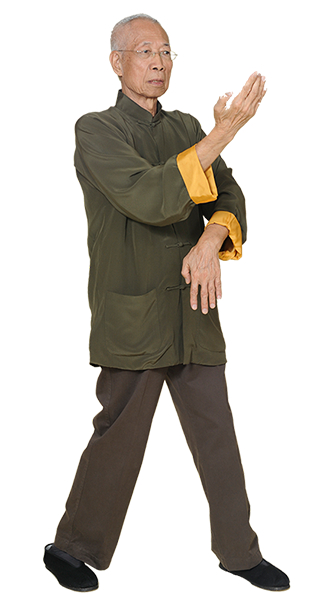Biu Gee is the third form-set in the Wing Chun martial art. Traditionally Biu Gee has been regarded as prohibited to outsiders. Grandmaster Ip Man had also mentioned that it would not be taught to others not of his lineage. This might be due to some old thinking that heritage is private, or due to the fact that those who have not built a solid foundation in Wing Chun are not ready to receive Darting Fingers training.
Grandmaster Chu Shong Tin believed the latter explanation to be more reasonable. In fact, the idea of Biu Gee is completely different to that of Siu Nim Tao and Chum Kiu. Its name already hints at the idea of offence! The power from the entire body can be mobilized up to the palm and fingers, enabling massive destruction – it is a very practical set of techniques in combat.
Darting Fingers

Under the influence of the tradition “prohibited to outsiders” and the fantasy of Biu Gee’s high offence techniques, learners are prone to mistakenly associate learning Darting Fingers to being experts in Wing Chun. They yearn for accelerated access to its training, or start on their own by imitation, diminishing into mere copy-cats. Undoubtedly Biu Gee is practically geared to combat. However, operating Darting Fingers is completely based on the achievements in Siu Nim Tao and Chum Kiu training. For ideal and serious Wing Chun training, Biu Gee should not be taught without considering a learner’s readiness -this is, rather, the correct attitude to heightening the learner’s final attainment.
Biu Gee rides on the structure combined in Siu Nim Tao, the Forward and Backward Stepping skills and the rotational power acquired in Chum Kiu. The resultant power is converged into the arms by intention, implementing speedy attacks that already have inserted the propelling momentum of the body weight. The faster the body weight moves (forward or backwards) and rotates, the more destructive a hand-form will result once the power has been accumulated onto the attack point.
Every hand-form in Biu Gee should be performed speedily – channeling the power of body weight into both arms through rotating, similar to the way of using rotation as the major power source in the discus throw and shot-put athletic sports. Punching is rare in Biu Gee; its palm striking, on the other hand, can be analogously described as striking in softball, or as swinging a club when playing golf: cumulating power onto the point of striking on the softball bat (or the golf club).
Differences in this Art
The difference is that the bat (or the club) is an external object, while the arms are a part of the body; as such, in Darting Fingers, the shoulders serve as the hands holding the bat (or the club). Of course, the technique employed is quite different: in the cases of the sports, the weight of the bat (or the club) mostly falls on the part for striking; in the case of Biu Gee, the attacking point of a palm strike is actually a light part of the body, involving the converging of the body weight power onto the attack point should the palm strike be impactful. This requires high-level skill.
A further difference is that in the sports there is sufficient time for the player to concentrate in figuring out the sequence of actions for launching a strike -success relies on the quality of concentration. In a martial art, strikes are exchanged as if in light speed, and they could possibly cause harm to the body. This is why a solid foundational structure is so important and is the reason for tightening up the passing down of Biu Gee. One might proclaim that practicing Darting Fingers is just for the purpose of exercise. Such reason shows nothing but one’s greed that drives for excessive quantity, spoiling the remarkable techniques and the highly artistic structure of Biu Gee.
The Outcome
It follows logically that if the foundation of pivoting has not yet been well grasped in Chum Kiu training, the movements in Darting Fingers will not succeed through sudden and rapid rotations. If Nim Tao has not been acquired in SNT training, the power in the body will stay scattered in the trunk and the limbs – not being connected into one – failing the expected mechanics of Biu Gee; in such case Biu Gee training would rather cause adverse effects: disconnected limbs, unstable and shaky body.
Hand-Forms
Every hand-form in Biu Gee is performed at its highest speed, affecting the bi-axial rotational forces in the body trunk and the limbs, manifesting the impactful power generated by dual-speed operation. The higher the rotational speed, the more power generated. Elbowing is a major emphasis in Biu Gee. Elbowing is relatively slow in offence, short in reach – only employed in short-range attack – the power generated is nevertheless more solid, and thus more destructive.
In summary, the conception of Biu Gee revolves around the speed of rotation and the speed of arm movement. By leveraging on the rotation of the body accorded with speed, it turns the body into a revolving sphere – transmitting power generated by high-speed rotation onto the elbow, the forearm, up to the palm and the fingers for launching powerful attacks. This is the way power is channeled up to the fingers and is also the reason for the name ‘Biu Gee’ (‘Darting Fingers’). As such, when having been familiar with the movements of Biu Gee, one should perform them at the highest possible speed. Among the form-sets of Wing Chun, Biu Gee is the one requiring the most strenuous effort in training.
Read The Wonders of Biu Gee Part 2
